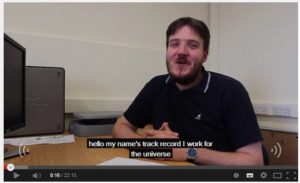YouTube subtitling – accessibility in video training
On 23 October, I attended a workshop session intended to introduce ideas for generating video subtitles, in order to enhance the availability and accessibility of our video training.
I’ve recently been considering video training as a potential solution to providing low-cost, regular and reusable training materials for users of the University CMS:
When we produced the video, we were aware that there are barriers to use of videos, such as: volume/sound quality, working in offices where you can’t play sound, hearing issues/disabilities – and of course, the Scottish accent. Using subtitles could therefore help make our video training available to as large an audience as possible, and adhere to the accessibility standards that we promote.
YouTube “Automatic Captions”
YouTube does have an “auto-subtitle” feature, titled “Automatic Captions”, which tried its best to render my brogue; but produced somewhat comical results. Here’s an attempt to transcribe the sentence – “Hello, I’m Duncan MacGruer and I work for the University…).
Fortunately, the workshop showed us just how easy it can be to correct these. It’s possible to edit both the words that appear in the captions, and the duration they appear on screen. It would be possible to do all of this from scratch, but even the experience of doing the first couple of minutes led me to wince when considering just how long that would take. At the rate I was working (admittedly, as a novice user of the subtitling editor), I estimated that I could only correct the subtitles for one minute of video every ten minutes of editing time. I’m hopeful that I’d get better, but it’s still a significant overhead when considering the duration and number of videos we produce.
I understood from the workshop that the automatic caption function will work better when uploading a transcript alongside the video, and that’s certainly something I’d consider in future – up till now, I’ve worked from notes only, meaning that hesitations in speech are picked up and appear in the subtitles. Working to a script might help not only with the automatic subtitles, but with encouraging me to stick to the point, too.




Nice write-up Duncan, glad you found the workshop useful. It was great to see you putting it to good use straightaway with your own videos.
If anyone else is interested you can download my free YouTube subtitle tutorial here – http://bit.ly/subtitle-workshop